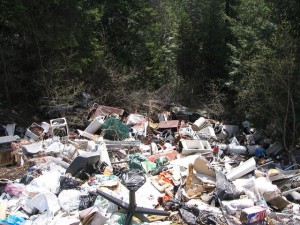Relearning the “3 R’s” and More in a World of 7 Billion and Growing
Apr 17th, 2012 | By admin | Category: Consumption and WasteBy Suzanne York, HowMany.org, April 17, 2012
Many people are familiar with the mantra “reduce, reuse, recycle” and it has never been more important than now. A group called Business Degree has created an infographic called “The Secret Life of Garbage” detailing the amount of waste created in the United States and China.
A few “highlights” from the graphic:
-
the U.S. produces 250 million tons of trash per year – enough to cover the state of Texas twice;
-
80% of items thrown away in the U.S. are recyclable (so much for the “3 R’s”);
-
China produces 254 million tons of garbage per year – which is 1/3 of global annual garbage output;
-
40% of trash in China is illegally dumped;
-
the world throws away over 750 million tons of garbage each year.
Societies have always created a lot of waste. What is most concerning today is that there are 7 billion people on the planet, and in the U.S. and China alone, over 1.6 billion people. By 2050 there will be at least 9 billion of us. More people means more garbage.
Then there is the inequality factor. In a world where one billion people go hungry, one billion people overconsume. Americans, who represent only 4 percent of world population, consume 25 percent of all resources. As more countries have increasing numbers of people rising to the middle class, the rate of consumption, in particular high consumption lifestyles, and waste it generates, becomes a greater concern.
Furthermore, as the world becomes more urban – it is predicted that 70% of the population will be urbanized by 2050 – there will be more waste.
According to the Food & Agriculture Organization (FAO), roughly one-third of food produced for human consumption is lost or wasted globally, which amounts to about 1.3 billion tons per year. In medium- and high-income countries food is mainly wasted at the consumption stage, meaning that it is discarded even if it is still suitable for human consumption. Notably, food wasted by consumers in rich countries (222 million tons) is roughly equal to the entire food production of sub-Saharan Africa (230 million tons).
For the planet’s sake, society should continue to reduce, reuse, recycle, and minimize waste. Products should include life-cycle assessments, which analyzes the environmental and human health impacts associated with a product, process, or service across its entire life-cycle – from cradle to grave. There is also a cradle to cradle framework, which strives to “create economies that purify air, land, and water, that rely on current solar income and generate no toxic waste, that use safe, healthful materials that replenish the earth or can be perpetually recycled, and that yield benefits that enhance all life.”
Other positive projects include generating more energy from waste, especially from landfills, and encouraging “pay-as-you-throw” programs (charging for a bag of garbage) to reduce the amount of waste before it even hits the landfill.
Perhaps most importantly we should revamp an economic policy based on endless growth in a world of finite resources. Many alternative GDP measures already exist that incorporate sustainability and economic well-being, such as the Genuine Progress Indicator that calculates environmental and social factors.
With global population still rising, and more people adopting a higher class lifestyle, we should prioritize tackling how much household and commercial waste we emit, as well as our levels of extravagant and inequitable consumption.
And for kicks, be sure to check out the Story of Stuff, an animation video about our consumerist society and how to create a more sustainable world.
Suzanne York is a senior writer with the Institute for Population Studies/HowMany.org.

